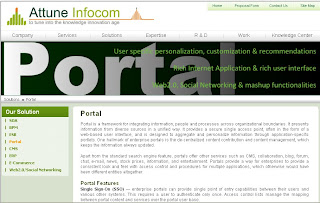
web portal development training
alfresco training, liferay training, soa training, drupal training, joomla training, mule training, jboss training, jbpm training, esb training
Apart from the standard search engine feature, portals offer other services such as CMS, collaboration, blog, forum, chat, e-mail, news, stock prices, information, and entertainment. Portals provide a way for enterprises to provide a consistent look and feel with access control and procedures for multiple applications, which otherwise would have been different entities altogether.
Portal Features
Single Sign-On (SSO) — enterprise portals can provide single point of entry capabilities between their users and various other systems. This requires a user to authenticate only once. Access control lists manage the mapping between portal content and services over the portal user base.
Integration — the connection of functions and data from multiple systems into new components/portlets/web parts.
Federation — the integration of content provided by other portals, typically through the use of WSRP or similar technologies.
Personalization — Users can customize the look and feel of their environment. Customers can edit and design their own web sites which are full of their own personality and own style; they can also choose the specific content and services they prefer. Also refers to the ability to prioritize most appropriate content based on attributes of the user and metadata of the available content.
Permissioning — the ability for portal administrators to limit specific types of content and services users have access to. For example, a company's proprietary information can be entitled for only company employee access.
Web2.0 / Social Networking
"Web 2.0" refers to what is perceived as a second generation of web development and web design. It is characterized as facilitating communication, information sharing, interoperability, User-centered design and collaboration on the World Wide Web. It has led to the development and evolution of web-based communities, hosted services, and web applications. Examples include social-networking sites, video-sharing sites, wikis, blogs, mashups and folksonomies.
Web 2.0 is neither a product nor an application that is used directly. Rather, it is a list of de facto standards and features that aim to utilize the way people use and interact with websites. It focuses on implementing websites best practices, such as Amazon and Flicker, in order to increase the chance of building a successful website. These standards impose some constraints on the websites development team in terms of usability, accessibility, and providing rich user experience. For developers, Web 2.0 requires the use of new technologies such as Ajax to create Rich Internet Applications (RIA) and Really Simple Syndication (RSS) to deliver the site content asynchronously to other parties.
Nowadays, more and more companies are moving toward standardizing their websites using Web 2.0 as a reference. The most obvious benefit that comes with Web 2.0 is the user comfort when browsing the site increasing his/her potential to buy services and products. Moreover, Web 2.0 increases the chances of sites’ success since they are built using the best practices in the industry. Web 2.0 opens a new horizon of services like RIA experience that was not possible by sticking with old technologies.
